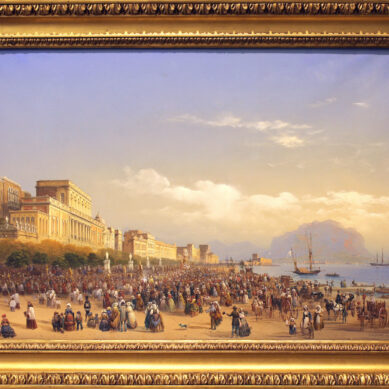You searched
Painter
Gaetano Gigante
Are you interested in the sales or the purchase of his artworks?
We buy works of this artist
and of other painters and sculptors from the 16th century to the first half of the 20th century
The Berardi gallery offers a free and without obligation service for evaluation of ancient and modern art . To find your way in the art market, very complex and full of nuances, it is better to rely on a professional consultant who can answer fast and concretely to your needs. The clarity of the answers will resolve effectively the need to estimate or sell an asset.
Contact us immediately without commitment
Answers also in 24 hours:
Gaetano Gigante
Gaetano Gigante
The full-length portrait of the Greek soldier who, based on the inscription on the frame of the painting, identifies himself as a Corporal of the Irregulars, is an unpublished painting by Gaetano Gigante. Artist active in Naples between the 18th and 19th centuries, Gigante was the father of the famous landscape painter Giacinto Gigante, considered to be one of the leading figures of the Posillipo School. The first letter “G” could be interpreted as Giacinto, but the model and the style of the painting does not cast a shadow of doubt on the attribution to Gaetano Gigante, an acclaimed “figurista” (figure painter). The artist trained at Giacinto Diano’s school and was active in Naples, the capital of the Kingdom of the Two Sicilies under the Bourbons during the difficult transition phase between the 18th and 19th centuries – a time when figurative trends from the late Baroque tradition continued into the new century, when the new romantic style of painting was about to emerge.
The subject belongs to the recurring themes of the artist’s production – figures and portraits – but in this specific case, it has a particular significance because the soldier depicted is wearing the Tsoliades uniform, a very special uniform that reproduces the attire of the Klephts, heroic opponents of the Ottomans during the period of the Turcocracy (1453-1821). Becoming a symbol of the struggle for liberation from the Turks, the Klephts uniform was officially adopted after the 1821 revolution as the national costume of all leaders of irregular formations and fighters of the revolution.
They wear a characteristic outfit consisting of a fine cotton shirt with wide sleeves, a richly decorated fermeli (waistcoat) and the fustanella – a 30-metre-long white fabric skirt with 400 folds, symbolically signifying the years of Ottoman suppression. On the feet we see hand-sewn red leather slippers with one toe covered by a black pom-pom. The sole has 60 nails, to hit the enemy. Finally, the headwear, a fario, made of red cloth with a tassel elegantly falling over the shoulder. Red symbolises the colour of blood, the tassel represents the tears shed for the liberation from slavery, black stands for mourning.
The soldier is equipped with combat weapons, stowed on the front in a leather pouch, like a belt pouch, where a flintlock pistol and a “yatagan” – a blade with two curved ends of ancient Turkish-Ottoman derivation and a precious ivory handle – can be glimpsed.
Corporal of the Irregulars refers to a figurative model deriving from the fervent patriotic participation in the phenomenon known as “pro-Hellenism”, whose historical period is traced between the third and fourth decades of the 19th century when, from 1820-21 the struggle for the liberation of the Greeks from Turkish oppression spread to the surrounding territories, shaking the spirits with a general awakening of consciences in the Balkan nations, in the Kingdom of the Two Sicilies and in Piedmont, where there was a popular insurrection against the Restoration and the Holy Alliance.
In a climate of exalted patriotism due to the audacity of the Greek insurgents, the early Hellenic ferments encouraged Italy in the rise of a libertarian idea that had its proselytes in the Carboneria (Cf. A. G. Noto, Le “nazioni sorelle”. Affinità, diversità e influenze reciproche nel Risorgimento di Italia e Grecia, in Il Risorgimento Italiano e i movimenti nazionali in Europa edited by G. Altarozzi and C. Sigmirean, Rome 2013, pp.43-68). These aspects of history were echoed in the figurative culture of the time and nourished the creation of famous commemorative themes such as The Death of Marco Botzaris (second version in Athens, Benaki Museum), executed in 1836 by Filippo Marsigli, as well as the genesis of a masterpiece by Ludovico Lipparini executed in 1841 that also proposes the subject of Marco Botzaris killed in the field, indirectly emphasising the value of the heroic sacrifice of Greek fighters (Cf. C. Spetsieri Beschi, La morte di Marco Botzaris di Filippo Marsigli/un quadro del filellenismo napoletano in “Napoli Nobilissima”, V, fasc. V-VI, 2004, pp. 199- 214).
Returning to the figure of the soldier painted by Gaetano Gigante, one can hypothesise a collaboration of the “figurist painter” who might have helped the complex scenographic construction of the Marco Botzaris by Marsigli (original title: L’alba del 21 Agosto 1824 a Carbonizza, ove si difende vigorosamente il corpo di Marco Bozzari- Gran Quadro, in C. Napoli, Le biennali borboniche, Catalogart 2009, pp. 130-132), one of the masterpieces of the new history painting at the 1839 Bourbon biennale. As sources state, the painting depicted the episode with a large scene containing more than fifteen figures, executed life-size (in Neapolitan “palmi” 21×16), and it is not at all impossible to think that the artist could have used the help of our painter in such a complex elaboration of the work, during the phase of setting up the characters in period costume.
Luisa Martorelli





